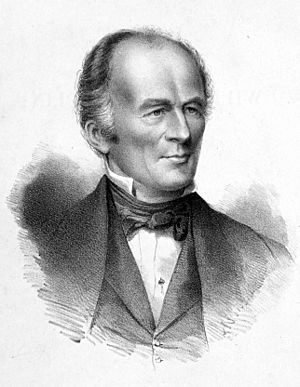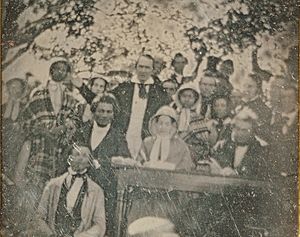William L. Chaplin facts for kids
Quick facts for kids
William Lawrence Chaplin
|
|
|---|---|

William Lawrence Chaplin, c. 1851
|
|
| Born | October 27, 1796 |
| Died | April 28, 1871 (aged 74) Cortland, New York, U.S.
|
| Occupation | Abolitionist, lawyer |
| Known for | Underground Railroad general agent, Liberty Party candidate for lieutenant governor and then governor |
| Spouse(s) | Theodosia Gilbert Chaplin |
| Children | 2 |
William Lawrence Chaplin (born October 27, 1796 – died April 28, 1871) was an important leader in the movement to end slavery in the United States. This movement was called abolitionism. People knew him as "General Chaplin." He worked for the American Anti-Slavery Society and was a main helper for the Underground Railroad. He was even put in jail for helping two people escape slavery. It cost a lot of money, $25,000, to get him out of jail and safely out of Maryland. He also worked as an editor for two newspapers that were against slavery. For a few years, he was a lawyer who studied at Harvard. Later in life, he and his wife ran a health spa called Glen Haven Water Cure.
Contents
Early Life and Education

William Chaplin was born on October 27, 1796, in Groton, Massachusetts. His father, Daniel Chaplin, was a minister. His mother was Susanna Prescott Chaplin. William's grandfather, Colonel William Prescott, was a hero at the Battle of Bunker Hill during the American Revolution.
In 1804, William started school at Andover Academy. He later went to Harvard College in 1819. He studied there for four years but did not finish his degree. He then studied law with Judge Dana and became a lawyer in June 1829.
William married Theodosia Gilbert on August 12, 1851, in Glen Haven, New York. Theodosia's parents were Betsey and Deacon Elias Gilbert. William and Theodosia had two children. Their daughter, Harriet Lawrence, was born in 1852 and passed away when she was nine years old. Their second daughter, also named Theodosia Gilbert, was born in 1855. She later married Reverend Frederick John Clegg Walton. The family went to the First Congregational Church of Pittsfield.
Fighting for Freedom
From 1829 to 1837, Chaplin worked as a lawyer in Massachusetts. By 1833, he became an abolitionist. This meant he strongly believed that slavery should be ended. He joined the new American Anti-Slavery Society. He decided to stop being a lawyer to spend all his time fighting against slavery.
In 1837, he moved to Utica, New York. There, he became a main helper for the New York Anti-Slavery Society. Other abolitionists called him "General Chaplin" because of his leadership. He also worked as an editor for two anti-slavery newspapers, the American Citizen and the Albany Patriot. He even reported on news from Washington D.C. for these papers.
In 1840, Chaplin joined a group led by Gerrit Smith to form the Liberty Party. This political party wanted to end slavery completely. Chaplin ran for important political jobs in New York. He was a candidate for lieutenant governor in 1846 and for governor in 1850.
Helping People Escape Slavery
In 1846, William Chaplin moved to Washington, D.C. He became an agent for the Underground Railroad. The Underground Railroad was a secret network of safe houses and routes. It helped enslaved people escape to freedom in the North or Canada. A group called the Vigilance Committee gave money to help buy freedom for enslaved people or to help them escape.
Chaplin worked with Daniel Bell, a free Black man. Together, they planned and paid for many escapes. One famous event was the Pearl incident in 1848. They tried to help 77 enslaved people escape from Washington, D.C. In November 1848, Chaplin also helped buy the freedom of the Mary and Elizabeth Edmonson, who had tried to escape during the Pearl incident.
Chaplin wanted to do even more to fight slavery. In 1848, he called for direct action to help people escape. Around 1849 or 1850, Chaplin helped Mary Jane (Stella) Weems, the sister of Anna Maria Weems, and the Young family escape to freedom.
Chaplin's Arrest and Support
In August 1850, Chaplin was arrested. He had helped two enslaved men, Allen and Garland H. White, escape. These men were owned by important politicians from Georgia. Chaplin had picked them up in a carriage near the Maryland-Pennsylvania border. But the carriage was stopped in Silver Spring, Maryland. Chaplin was hit, and shots were fired. Allen was captured, and Garland was caught a few days later.
Chaplin was held in jail for several weeks, first in Washington D.C., then in Rockville, Maryland. His friends and supporters raised a lot of money to help him. This money came from donations to the Chaplin Fund Committee. Gerrit Smith, a well-known abolitionist, and others paid $19,000 for his bail. The total cost to make sure he was safe when leaving Maryland was $25,000. Chaplin later left Maryland without going to court, which meant the money was not returned. He gave lectures against slavery to help get money back for those who had donated.
Chaplin's minister, Rev. John Todd, spoke up for him in a newspaper. He said Chaplin had "one of the noblest, most self-sacrificing, unselfish hearts." A historical marker in Ellicott City, Maryland, mentions Chaplin's case. It says the courthouse was used for cases about people who helped enslaved persons run away.
In August 1850, a meeting called the Cazenovia convention was held in Cazenovia, New York. This meeting happened because people were worried about a new law called the Fugitive Slave Act of 1850. Frederick Douglass and the Mary and Elizabeth Edmonson attended, along with about 30 other formerly enslaved people. Since Chaplin was in jail, his future wife, Theodosia Gilbert, went to the meeting for him.
Later Years

In 1851, William L. Chaplin joined his wife, Theodosia, and James C. Jackson in running the Glen Haven Water Cure spa. This spa was located on Skaneateles Lake, New York. William and Theodosia were married there on August 12, 1851.
Theodosia passed away on April 11, 1855, after their second child was born. William Chaplin died at his home on April 28, 1871, in Cortland County, New York. William, Theodosia, and their daughter Harriet are buried at the Cortland Rural Cemetery.

